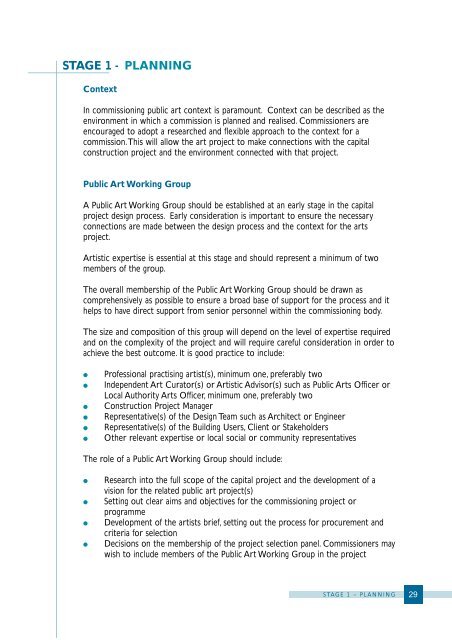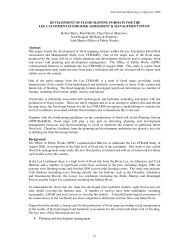per cent for art scheme - The Office of Public Works
per cent for art scheme - The Office of Public Works
per cent for art scheme - The Office of Public Works
Create successful ePaper yourself
Turn your PDF publications into a flip-book with our unique Google optimized e-Paper software.
STAGE 1 – PLANNING<br />
Context<br />
In commissioning public <strong>art</strong> context is paramount. Context can be described as the<br />
environment in which a commission is planned and realised. Commissioners are<br />
encouraged to adopt a researched and flexible approach to the context <strong>for</strong> a<br />
commission.This will allow the <strong>art</strong> project to make connections with the capital<br />
construction project and the environment connected with that project.<br />
<strong>Public</strong> Art Working Group<br />
A <strong>Public</strong> Art Working Group should be established at an early stage in the capital<br />
project design process. Early consideration is important to ensure the necessary<br />
connections are made between the design process and the context <strong>for</strong> the <strong>art</strong>s<br />
project.<br />
Artistic ex<strong>per</strong>tise is essential at this stage and should represent a minimum <strong>of</strong> two<br />
members <strong>of</strong> the group.<br />
<strong>The</strong> overall membership <strong>of</strong> the <strong>Public</strong> Art Working Group should be drawn as<br />
comprehensively as possible to ensure a broad base <strong>of</strong> support <strong>for</strong> the process and it<br />
helps to have direct support from senior <strong>per</strong>sonnel within the commissioning body.<br />
<strong>The</strong> size and composition <strong>of</strong> this group will depend on the level <strong>of</strong> ex<strong>per</strong>tise required<br />
and on the complexity <strong>of</strong> the project and will require careful consideration in order to<br />
achieve the best outcome. It is good practice to include:<br />
●<br />
●<br />
●<br />
●<br />
●<br />
●<br />
Pr<strong>of</strong>essional practising <strong>art</strong>ist(s), minimum one, preferably two<br />
Independent Art Curator(s) or Artistic Advisor(s) such as <strong>Public</strong> Arts <strong>Office</strong>r or<br />
Local Authority Arts <strong>Office</strong>r, minimum one, preferably two<br />
Construction Project Manager<br />
Representative(s) <strong>of</strong> the Design Team such as Architect or Engineer<br />
Representative(s) <strong>of</strong> the Building Users, Client or Stakeholders<br />
Other relevant ex<strong>per</strong>tise or local social or community representatives<br />
<strong>The</strong> role <strong>of</strong> a <strong>Public</strong> Art Working Group should include:<br />
●<br />
●<br />
●<br />
●<br />
Research into the full scope <strong>of</strong> the capital project and the development <strong>of</strong> a<br />
vision <strong>for</strong> the related public <strong>art</strong> project(s)<br />
Setting out clear aims and objectives <strong>for</strong> the commissioning project or<br />
programme<br />
Development <strong>of</strong> the <strong>art</strong>ists brief, setting out the process <strong>for</strong> procurement and<br />
criteria <strong>for</strong> selection<br />
Decisions on the membership <strong>of</strong> the project selection panel. Commissioners may<br />
wish to include members <strong>of</strong> the <strong>Public</strong> Art Working Group in the project<br />
STAGE 1 – PLANNING 29
















